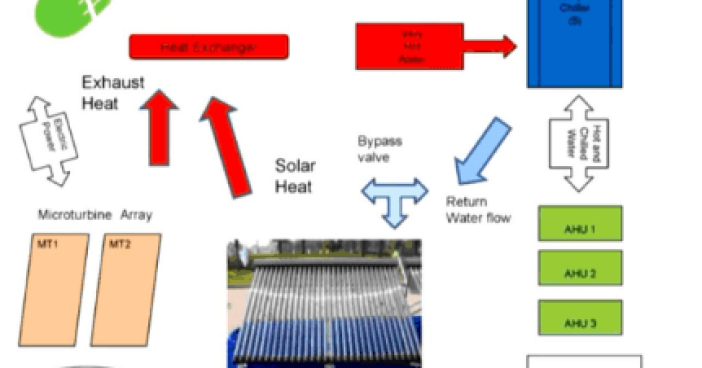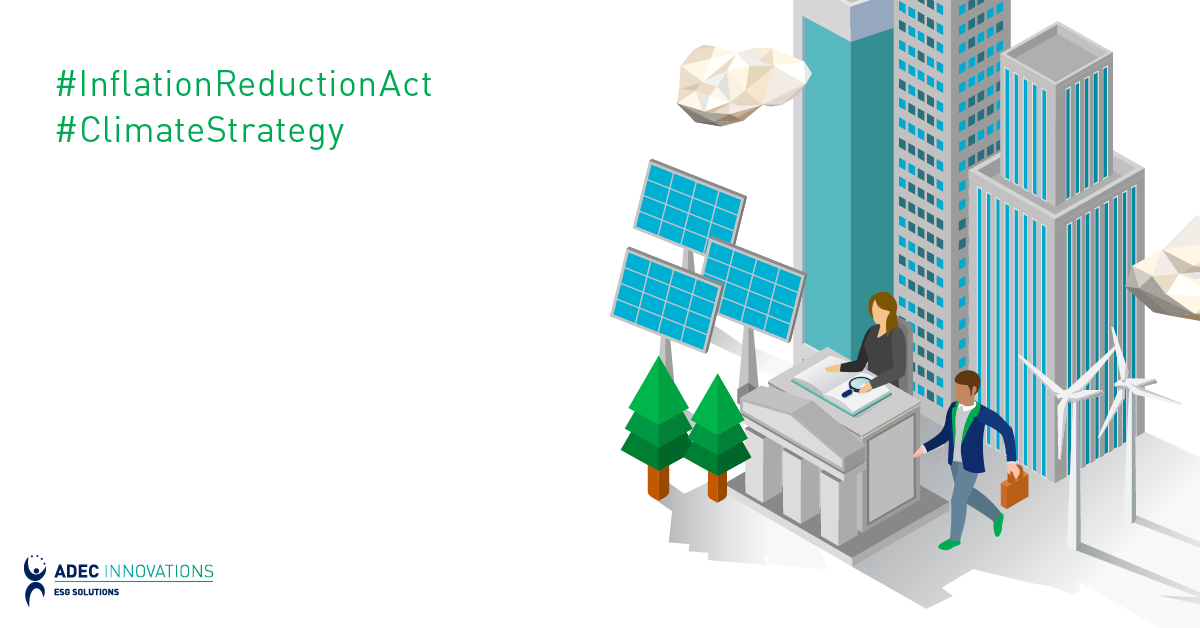In a previous blog post, the good (non-fossil) and bad (intermittent production) aspects of traditional renewable energy options (renewables) that produce electricity from photovoltaic (PV) panels and wind and water turbines were discussed, as well as thermal solar collectors that are used to produce hot water either for immediate use or that is stored for later use. In this post, the ways of combining the renewables with other energy production options at or near their point of use will be discussed.
These combined systems or integrated systems increase the usefulness of the renewables and overcome some of the intermittency challenges discussed in my previous post. These systems provide opportunities for both self-generation and cost reductions and the possible sale of energy to the utility or adjacent building when using combined heat and power (CHP). There are numerous solar integration possibilities such as the project in New Zealand (see Figures below). This recent tri-generation project combined the exhaust heat from the gas-fired microturbines that produces electricity with the solar thermal energy and used the heat produced in the absorption chiller to provide cooling. Using the renewables with fossil-fueled generation reduces ghg impacts and creates useful synergies between each production unit of the system.
The use of clean fuel for the turbines in order to produce electricity – and then using the heat from the exhaust with the heat from the solar array as the fuel for the absorption chiller to produce cooling – provided the following significant carbon credit offsets:
1) Electrical Power savings of 790kg/MW GHG over Coal-Fired generation. For the 1.67 MW system, this is 11,557tons/annum
2) Air conditioning replacing cooling from Coal-Fired generation of 3155kW/hr is 27,637MW/@ 1310kg/MW = 36,205tons/annum
3) Total Carbon Saved is (11,557 + 36,205) = 47,762 tons/annum
4) At $23/ton (New Zealand), this is $1098,526/annum or $10,985,260 in over 10 years
With the advent of a price on CO2, tri-generation is also applicable in North America using a variety of similar distributed energy resources in an integrated system to deliver electricity, heat, and cooling as required by our seasonal changes. A recent study by Wes Livingston, a design engineer at Power Partners – the world’s leading manufacturer of adsorption chillers and factory-built high efficiency tri-generation systems – shows the cost comparison and reduced CO2 emissions using tri-generation against traditional PV and grid-produced electricity and traditional gas boilers for heating, cooling, and power. The study shows that the use of PV is renewable and reduces CO2 but the electricity is still produced with high capital costs. The remaining grid electricity for cooling and the fossil fuel used for heating all produce more CO2 than the tri-generation system. Integration of energy systems rather than using low cost individual systems produces better life cycle benefits if designed properly and installed as well as for sustainable results.
Educating and encouraging communication among all stakeholders involved, such as energy producers, consumers and government regulators, is helping to correct entrenched misconceptions about renewables and onsite generation. For example, solar hot water and electricity systems have traditionally been designed and built separately. There is recognition now of the potential for integrated solutions like the Congenra, which combines the PV production in the center of the concentrated solar collector and gathers the heat from behind the PV cells and uses this for solar cooling, as explained in their white paper with the key points below. Solar cooling uses solar thermal energy to displace cooling powered by electricity (a costly energy source in most regions of the world), which results in both energy and costs savings. Summer-time use and demand charges constitute the highest percentage of most electric costs, but can be effectively offset by solar cogeneration with storage.
As shown in Table 1, solar cogeneration uniquely offers over 100% cooling efficiency, maximizing customers’ financial savings. Traditional photovoltaics, at 15% efficiency, provide electricity for high-efficiency mechanical chillers with a COP (Coefficient of Performance) of 5. The resulting system cooling efficiency is 75%. PV cooling efficiency: 15% PV * 5x COP = 75%.

Table 1: Efficiency comparison for solar cooling technologies
Stand-alone solar hot water systems capable of reaching very high temperatures at 60% efficiency can be integrated with a double effect absorption chiller with a COP of 1.3. This yields a slightly higher system of cooling efficiency at 78%. For solar cogeneration, temperatures are lower than stand-alone hot water systems to optimize photovoltaic efficiency and minimize system complexity. Solar cogeneration captures 15% efficiency with photovoltaics and 60% efficiency with solar hot water ones. The sun’s energy is captured and integrated to provide the most optimum cooling for the customer with the combined production of cooling from PV systems. Hot water produced by solar cogeneration yields a 117% cooling efficiency. Solar cogeneration cooling efficiency: 15% PV * 5x COP + 60% HEAT * 0.7x COP = 117%
Environmental Benefits
Solar cooling offers multi-faceted environmental benefits and displaces high life-cycle greenhouse gas-emitting electric use with minimal life-cycle emission solar production. Moreover, solar air conditioning technologies use environmentally sound materials with virtually no global warming potential. Traditional fluorocarbon refrigerants used in electrically driven chillers have high global warming and ozone depletion potential.
Solar cogeneration offers similar advantages over competing technologies in terms of reducing air pollutants other than carbon dioxide — including volatile organic compounds (VOC), nitrogen oxides (NOx), sulfur dioxide, carbon monoxide and particulate matter — both locally and averaged across the grid. The absolute and relative reductions depend on the mix of generating sources in the regional grid. Solar cogeneration also eliminates local emissions of pollutants compared to burning natural gas (either heating water in boilers or generating electricity and heating water using CHP). In some air quality districts, elimination or avoidance of VOC and NOx can obviate regulatory burdens and eliminate fines.
While the capital costs of renewables and clean onsite generations are higher than those of large central plants that benefit from the economies of scale, renewable costs are rapidly declining. To help overcome the higher initial renewable costs, many jurisdictions require their utilities to provide financial incentives. These programs vary by utility, but the regulators see that distributed energy resources provide a reduction in grid bottlenecks and new transmission lines, making renewables more feasible.
With the increased concern for climate change, information on energy use and impacts provide the framework for carbon offset programs. Renewable energy offers reduction in carbon and other environmental attributes, but if this renewable energy production or equipment is subsidized by the utility then they may require these credits to be transferred to them in order to reduce the cost of the subsidization programs that is spread over all their customers in the rates they charge.
The financial community that provides debt financing to the large utilities for traditional central generating stations has to adjust to the changes in the risks and borrowers in the much smaller renewable and distributed energy projects. In some cases if the renewable energy project helps the building reduce its overall energy costs and a business increase its profits, then the financing can be part of the normal mortgage and business transactions with the existing bank relationships. When the renewable energy project becomes the prime business on a site for programs like the long-term feed-in tariff or power purchase agreements with utilities, then the financial institutions see the risks differently. The benefit of having a long-term power purchase agreement is diminished somewhat by the energy production uncertainty due to weather and regulatory uncertainty, which is due to politicians changing their support for the renewable energy issue within each election cycle.
According to a recent University of Delaware study, with the right combination of resources and energy storage, renewables could provide all the electricity the U.S. electric grid needs 99.9% of the time by 2030 and it could be done at costs comparable to today’s. The study made the following recommendation: “Aiming for 90% or more renewable energy in 2030, in order to achieve climate change targets of 80-90% reduction of greenhouse carbon dioxide from the power sector, leads to economic savings.” They also said projected capital costs for wind and solar in 2030 will be roughly half what they are now.
The energy landscape is rapidly changing and renewable energy is becoming more prevalent. There is a significant effort to make our buildings become Net Zero. Renewable energy, clean distributed energy systems such as those described above and others like fuel cells and flywheels, will play a key role in overcoming some of the energy storage challenges and in achieving clean energy goals. If you wish to learn more about how your organization can incorporate renewable energy into your energy management plan, please click the link below.
Did you enjoy this post? The author of this article is David Katz. Learn more about him here.





